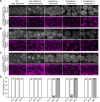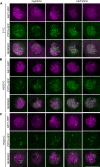Heat stress reveals a specialized variant of the pachytene checkpoint in meiosis of Arabidopsis thaliana
- PMID: 34718750
- PMCID: PMC8846176
- DOI: 10.1093/plcell/koab257
Heat stress reveals a specialized variant of the pachytene checkpoint in meiosis of Arabidopsis thaliana
Abstract
Plant growth and fertility strongly depend on environmental conditions such as temperature. Remarkably, temperature also influences meiotic recombination and thus, the current climate change will affect the genetic make-up of plants. To better understand the effects of temperature on meiosis, we followed male meiocytes in Arabidopsis thaliana by live cell imaging under three temperature regimes: at 21°C; at heat shock conditions of 30°C and 34°C; after an acclimatization phase of 1 week at 30°C. This work led to a cytological framework of meiotic progression at elevated temperature. We determined that an increase from 21°C to 30°C speeds up meiosis with specific phases being more amenable to heat than others. An acclimatization phase often moderated this effect. A sudden increase to 34°C promoted a faster progression of early prophase compared to 21°C. However, the phase in which cross-overs mature was prolonged at 34°C. Since mutants involved in the recombination pathway largely did not show the extension of this phase at 34°C, we conclude that the delay is recombination-dependent. Further analysis also revealed the involvement of the ATAXIA TELANGIECTASIA MUTATED kinase in this prolongation, indicating the existence of a pachytene checkpoint in plants, yet in a specialized form.
© The Author(s) 2021. Published by Oxford University Press on behalf of American Society of Plant Biologists.
Figures







Comment in
-
Back to the roots: A focus on plant cell biology.Plant Cell. 2022 Jan 20;34(1):1-3. doi: 10.1093/plcell/koab278. Plant Cell. 2022. PMID: 34755878 Free PMC article. No abstract available.
References
-
- Anderson P, Kedersha N (2008) Stress granules: the Tao of RNA triage. Trends Biochem Sci 33: 141–150 - PubMed
-
- Anderson TR, Hawkins E, Jones PD (2016) CO2, the greenhouse effect and global warming: from the pioneering work of Arrhenius and Callendar to today's Earth System Models. Endeavour 40: 178–187 - PubMed
-
- Armstrong SJ, Caryl AP, Jones GH, Franklin FC (2002) Asy1, a protein required for meiotic chromosome synapsis, localizes to axis-associated chromatin in Arabidopsis and Brassica. J Cell Sci 115: 3645–3655 - PubMed
-
- Armstrong SJ, Franklin FCH, Jones GH (2003) A meiotic time-course for Arabidopsis thaliana. Sex Plant Reprod 16: 141–149
Publication types
MeSH terms
LinkOut - more resources
Full Text Sources
Research Materials

